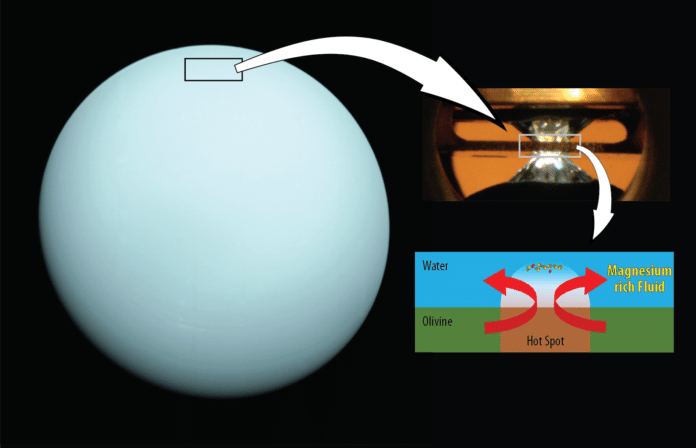Until now, scientists have successfully gained detailed knowledge of rocky planets in our solar system, but less is known about the icy water-rich planets Neptune and Uranus.
In conventional models of these planets, a thick water-rich layer is underlain by a separate rocky interior. Neptune and Uranus are expected to have particular separate layers, comprising an atmosphere, ice or liquid, a rough mantle, and a metallic core.
In a new study, scientists wanted to understand possible reactions between water and rock in the deep interiors of Neptune and Uranus. To do so, they re-created the temperature and pressure of the interiors of Neptune and Uranus in the lab.
The study offers a more powerful understanding of the chemistry of these planets’ deep water layers. It also offers clues to the composition of oceans on water-rich exoplanets outside our solar system.
Lead author Taehyun Kim of Yonsei University in South Korea said, “Ice giants and some exoplanets have very deep water layers, unlike terrestrial planets. We proposed the possibility of an atomic-scale mixing of two of the planet-building materials (water and rock) in the interiors of ice giants.”
To imitate the conditions of deep water layers on Neptune and Uranus in the research facility, the group primarily drenched explicit rock-forming minerals, olivine, and ferropericlase into the water and compacted the sample under extremely high pressure in Diamond-Anvil. Then, to screen the reaction among minerals and water, they took X-ray estimations while laser-heated the sample to a higher temperature.

The resulting chemical reaction prompts high concentrations of magnesium in the water. The findings suggest that oceans on water-rich planets may not have similar properties to Earth’s ocean. It also indicates that high pressure would make those oceans rich in magnesium.
Study co-author Sang-Heon Dan Shim of Arizona State University‘s School of Earth and Space Exploration said, “We found that magnesium becomes much more soluble in water at high pressures. Magnesium may become as soluble in the water layers of Uranus and Neptune as salt is in Earth’s ocean.”
“These characteristics may also help solve the mystery of why Uranus’ atmosphere is much colder than Neptune’s, even though they are both water-rich planets. If much more magnesium exists in the Uranus‘ water layer below the atmosphere, it could block heat from escaping from the interior to the atmosphere.”
“This magnesium-rich water may act as a thermal blanket for the interior of the planet.”
“If an early dynamic process enabled a rock–water reaction in these exoplanets, the topmost water layer may be rich in magnesium, possibly affecting the thermal history of the planet.”
In the future, scientists want to continue their experiments under diverse conditions to learn more about the composition of planets.
Other co-authors of this study include Stella Chariton and Vitali Prakapenka of the University of Chicago; Anna Pakhomova and Hanns-Peter Liermann of the Deutsches Elektronen Synchrotron, Germany; Zhenxian Liu of the University of Illinois, Chicago; Sergio Speziale of the German Research Center for Geosciences, Germany; and Yongjae Lee of Yonsei University, South Korea.
Journal Reference:
- Kim, T., Chariton, S., Prakapenka, V. et al. Atomic-scale mixing between MgO and H2O in the deep interiors of water-rich planets. Nat Astron (2021). DOI: 10.1038/s41550-021-01368-2
